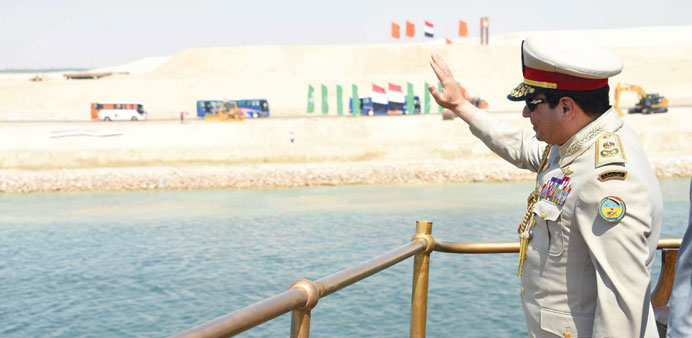Egyptian President Abdel Fattah al-Sisi stands in a boat on the Suez Canal as he attends the celebration of an extension of the waterway in Ismailia, Egypt yesterday. Sisi sees the new canal a symbol of Egypt’s glory and prosperity, and of independence since its nationalisation in 1956.
AFP/Cairo
An insecure Egyptian ruler, bullied as a child for his weight, was persuaded that a canal connecting the Mediterranean to the Red Sea would bring him glory—a monument rivalling those of his more illustrious predecessors.
Said Pasha, ruler of Egypt and Sudan from 1854 to 1863, never saw the completion of the canal, which opened six years after his death. He is remembered as the man who sold the rights to the waterway to the then-imperialist powers France and Britain.
A century and a half later, another Egyptian leader seeking to make his mark on history, President Abdel Fattah al-Sisi, decided to expand the Suez Canal.
Like Said Pasha before him, Sisi sees in the canal a symbol of Egypt’s glory and prosperity, and of independence since its nationalisation in 1956.
A canal from the Nile river to the Red Sea existed in the times of ancient Egypt, but was lost over the ages.
The idea was revived by French Consul Ferdinand de Lesseps, who persuaded Said Pasha to grant him a concession for building a waterway.
The canal, completed by de Lesseps’s Suez Canal Company, opened on November 17, 1869. Thousands of Egyptian workers died digging it.
In 1882, partly worried that the nationalist rebel leader Colonel Ahmed Urabi would seize power, defaulting on the country’s debt and taking over the canal, Britain invaded.
The British eventually withdrew from Egypt, leaving behind a pliant monarchy, but they continued to control the Suez Canal Company along with France, something that rankled another Egyptian colonel, Gamal Abdel Nasser.
Nasser was one of the leaders of a military coup that toppled the monarchy in 1952, and swiftly became president of the new republic.
Like every great Egyptian leader, or at least every Egyptian leader who aspired to greatness, he forthwith decided on a monumental project, the Aswan Dam.
But he could get no foreign funding on his own terms. He increasingly rattled Britain, France and Israel with his support for Algerian rebels and his bellicosity towards Israel.
Suez canal revenues were meanwhile filling other countries’ coffers.
On July 26, 1956, the charismatic Nasser gave an address to the nation, railing against the US, Britain and France and what he denounced as a plot to keep his country subjugated.
Nasser recounted a meeting with the head of the World Bank, Eugene Black, to secure funding for the dam.
“I started looking at Mr Black, as he sat before me on a chair, and I imagined that I was sitting in front of Ferdinand de Lesseps,” Nasser said.
The name of the French consul was a codeword to troops to seize the canal.
British premier Anthony Eden and French counterpart Guy Mollet were predictably enraged and began contemplating military intervention.
Together with Israeli Prime Minister David Ben Gurion, Eden and Mollet gathered in a villa outside Paris and hatched a plan.
Israel would invade Egypt, and France and Britain would drop troops in a show of intervening, conveniently seizing the Suez Canal in the process. The meeting was detailed in a study by Oxford University historian Avi Shlaim.
The operation began in October 1956, and went smoothly enough for the invaders until the US, in part seeking to avoid a confrontation with the pro-Nasser Soviet Union, led global efforts that forced France, Britain and Israel to withdraw.
Sisi ordered the extension to the canal shortly after his election last year, following the 2013 military overthrow of Islamist President Mohamed Mursi, setting off a deadly police crackdown on Islamists and a militant insurgency.
And — though French President Francois Hollande was the guest of honour at yesterday’s ceremony — Sisi has left no doubt that now Egypt’s hand is on the tiller when it comes to Suez. This time Cairo raised the funds for the canal project domestically.



